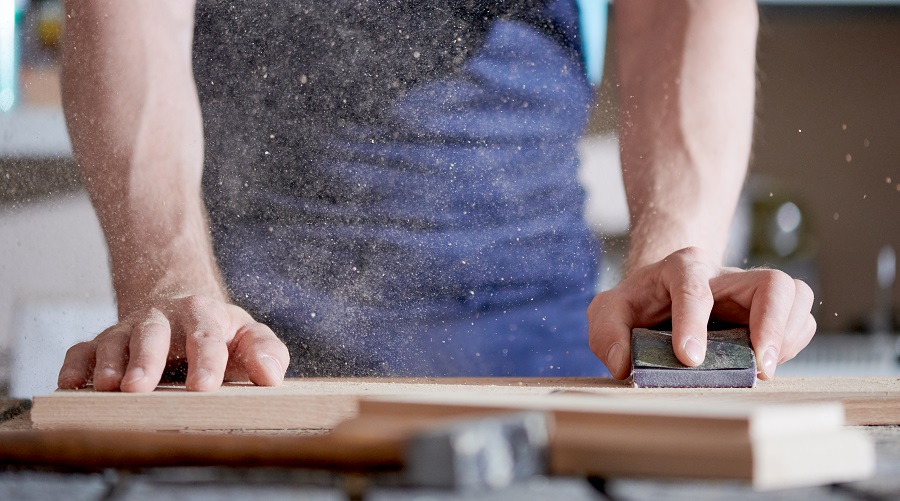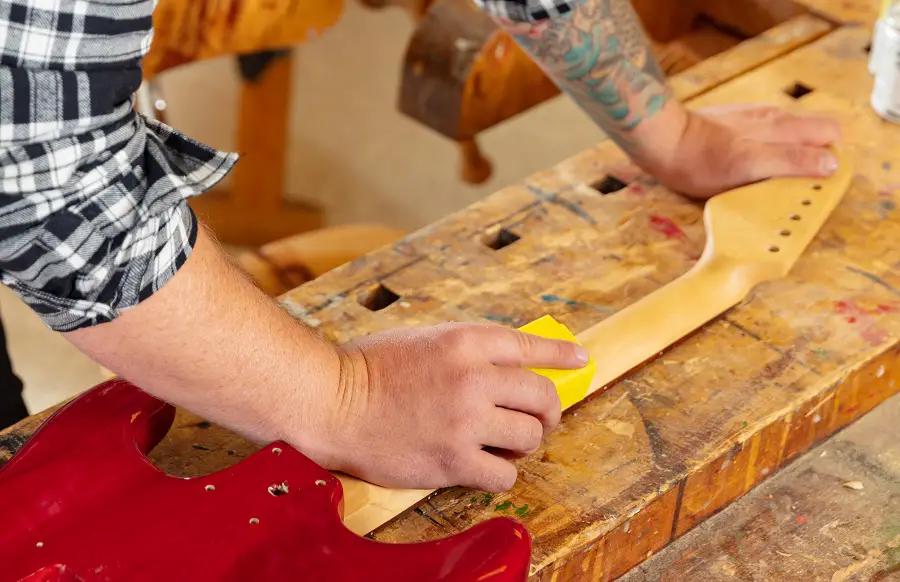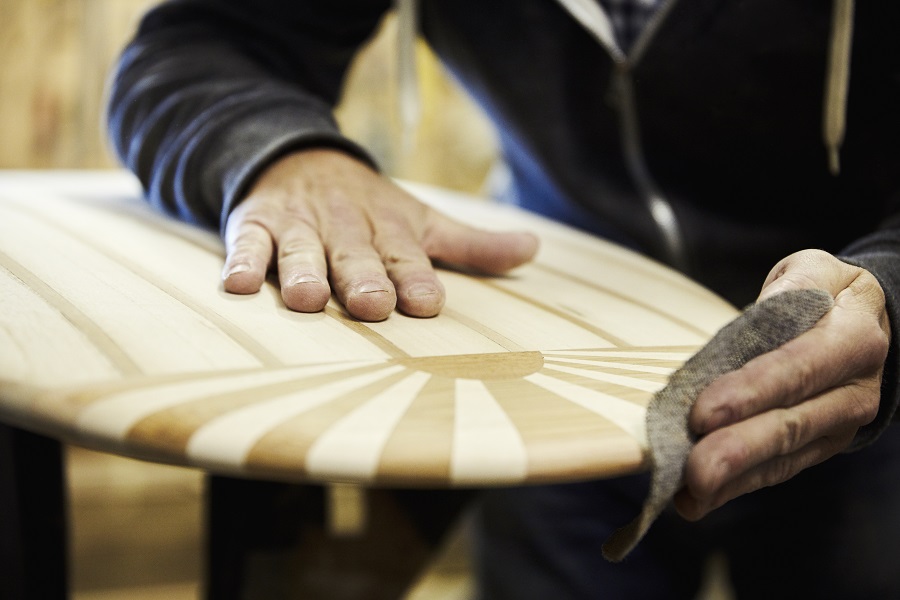Sanding wood is an important part of the finishing process. No matter how good the wood polishes, varnishes or paints used, without proper sanding you will not get a stain-free, hard-wearing and pleasant to the touch surface. By the time it reaches the sanding stage, the wood has already undergone natural or forced drying in dryers and mechanical processing. In the vast majority of cases, sanding is done dry, on the wood as it comes from the mechanical processing. However, there are situations where a slight wetting of the surface is necessary to achieve the desired results. Find out what these situations are, how wetting and sanding is done, what the advantages are and when this method should not be used.

What wet/wet sanding involves
Wet sanding is done to sand the wood more finely, to remove some defects that have occurred during mechanical processing or to reduce the amount of dust that results. A very fine sanding of the wood is not always desirable because undesirable consequences such as poor adhesion and staining may occur. We have written extensively about these consequences here. Typically, successive dry sanding with 80 and 150 grit or 120 and 180 grit paper is sufficient to achieve uniformly colored surfaces and good varnish adhesion.
There are situations, however, when wetting helps raise the fiber for better sanding in difficult areas. Difficult areas in terms of sanding are considered to be those with fiber ends, i.e. milled areas. In the past, factories used to wet these areas - called 'slippings' - with water in which a small amount of aracite was put. The finer sanding of the raised grain and the hardening of the aracite absorbed into the wood limited the absorption of the stain and the coloration was more uniform.
Moistening the wood will also reveal any scratches and indentations that may have occurred during mechanical processing. Otherwise invisible, scratches appear after finger-jointing, and the surface must be sanded to remove them and finger-jointed again. In the case of prints, water can help remove the defect, provided the fiber is clogged, not broken. Just run an iron a few times over a damp cloth placed over the impression and the wood will recover. If the impression is deeper, the operation will have to be repeated.
Dampening wood involves a light sprinkling, like ironing laundry, followed by immediately wiping off the excess with a cloth. A fine water spray system can be used. Another, much safer way is to wipe the surface with a cloth soaked in water and wrung out well. The wood should not be wet in abundance. Too much water can do more harm than good - it attacks the glue, loosens joints, stains the wood, swells the veneer. In addition, waterlogged wood does not sand well because sandpaper loads very quickly.
When to wet sand
Here are some of the products whose quality increases when wet sanded:
- toasters end grain,
- the bowls or pens obtained by turning,
- jewelry boxes,
- wood embedded in epoxy resin,
- musical instruments
Grinders need a very fine working surface to be of quality, and this is more difficult to achieve when the fiber ends form the surface. In order for the grinding to be done very well, and for its smoothness to prevent strong absorption, wet grinding is used. This results in a much finer sanding fineness than that obtained by dry sanding.
In the case of turned items, fiber ends exist practically all over the surface of the object. The very thin walls of a bowl, for example, need to be very fine, and this fineness can only be achieved by wet sanding. Wood that is resin-embedded to form a table top or decorative object also needs to look very fine, to be finely sanded. Here too, wet sanding is the best solution.
Wet sanding is also recommended for exotic wood or wood whose dust may be toxic. The resulting dust is greatly reduced by wet sanding, thus reducing the danger of allergies or other side-effects for the sander.

When wet sanding is not recommended
There are situations when wet sanding is not the best option, even if the object's shape or purpose would recommend it. Here are some of them:
- the object has many joints,
- are cracks in the wood,
- the adhesive used is not waterproof,
- The design of the object allows water to reach areas where wiping is difficult or impossible.
Dry sanding is recommended for furniture pieces. Very fine sanding can lead to poor varnish adhesion and reduced varnish absorption. In such cases, ordinary sanding with sandpaper up to 220 is sufficient to achieve good results. But the quality of the abrasives is also important. You can find more information on how to choose the right abrasives here here.
Also, if the exhaustion system is good dust problems disappear and dry sanding can be used.
How to achieve very fine surfaces using water when sanding
There are 2 ways to sand using water as an aid. The most commonly used is the moistens the surfaceThe fiber is sanded dry with ordinary sandpaper. The waiting time depends on the conditions in the working environment (humidity, temperature, air currents) and can be up to one hour. If the surface is coarse, it is better to sand initially, without wetting, with 120 grit. Then moisten and leave it to dry, then sand at 180. Dewax and moisten again. After buffing, sand with 240. The operation is repeated using 280, 320, 360 and 400 paper. A very smooth surface with a discreet sheen is obtained.
The second method is to moisten the sanding paper. In this case, special water-resistant sandpaper must be used. The paper is moistened in a bowl of water and used wet. The difference with the above method is that the grain of this paper is much finer. Start with 200 grit and continue with 500, 1000, 1500 and so on until the desired fineness is reached. You can go up to 4000, 5000 and even more and the result is a very fine surface with a gloss that makes the wood look lacquered. Throughout sanding the paper must be wet. If it seems to have dried, it is put back into a bowl of water for a while. In contrast to the other method, this method does not produce any dust at all because it is retained by the sandpaper. This method is often used by wood turners.
In both cases it can be sanded by hand or with hand sanding machines. With wet sanding, circular sanding is also possible, but when wet paper is used, movement along the grain is recommended. When using wet sanding machines with wet paper, make sure that there is no danger of electrocution.

I hope you find the information interesting. If you have used this method to sand wood, please share your experience with us. And if you have any questions or queries, leave them below in the dedicated space. I will be sure to reply.




































Add comment